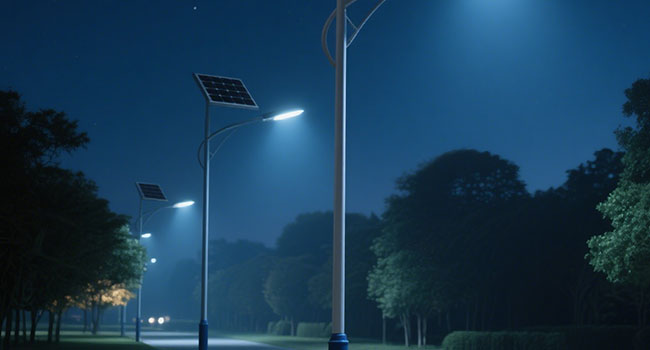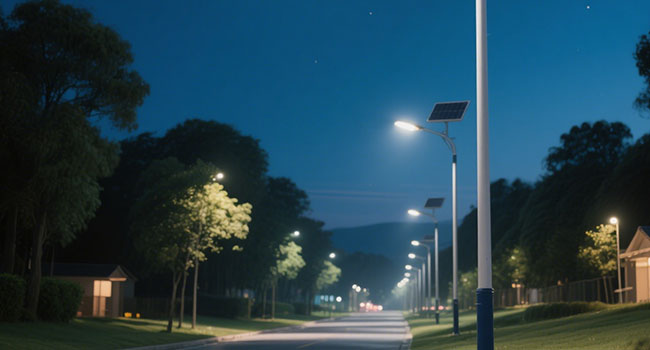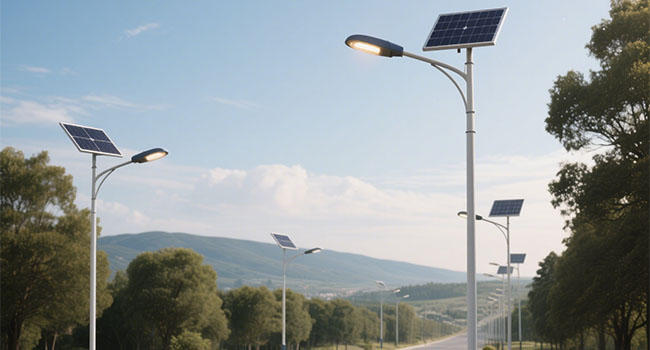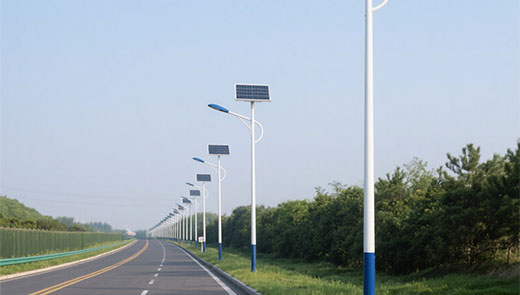Installation and Maintenance Guide for Solar Street Lights
At a time when the concept of sustainable development is deeply rooted in people's hearts, solar street lights, as the green carrier of "sunlight into light", are accelerating the replacement of traditional lighting facilities. Data shows that a standardized solar street light system can recover the initial investment cost within 5 years, and the carbon emission reduction of the whole life cycle is equivalent to planting 300 square meters of fir forest. However, problems such as "inefficient operation" and "life depreciation" due to sloppy installation or lack of maintenance are common in practical applications. This paper relies on the refinement of four core modules: Precise Layout, Module Adaptation, Cycle Maintenance, and Intelligent Troubleshooting, to provide managers with a reusable blueprint for operation, and to help unleash the maximum efficiency of solar lighting.

Installation Guide: Precise Layout to Ensure Efficiency
Site Selection and Layout
The site selection of solar street lights should be based on the annual average sunshine hours and geographical location. For example, Reunion Island in France is a typical area for efficient operation of solar street lights due to its 2200-2500 hours of average annual sunshine. When selecting a site, it is necessary to ensure that the solar panels have no shading throughout the day, and at the same time optimize the layout in combination with the road conditions:
|
Road Type |
Width |
Number of Lights (One Side) |
Spacing |
Design Objective |
|
Two-Way Four-Lane |
10 meters |
2–3 lights |
20–30 meters |
Uniform illumination + Glare prevention |
|
Urban Branch Road |
6–8 meters |
1–2 lights |
15–20 meters |
Basic lighting coverage |
In addition, it is necessary to avoid high-rise buildings, dense vegetation and other obstructions to ensure that the lighting range covers sidewalks, driveways and intersections.
Component Configuration
Solar Panel: Solar panel is the energy source of the system, and its specification directly determines the power generation capacity. Take the mainstream 200W monocrystalline module as an example, under standard lighting conditions (1000W/m² irradiance, 25℃), the average daily power generation can reach 800Wh, which is enough to support 100W LED lamps to light up for 8 hours at night (including 20% redundancy in energy conversion loss).
Lead-acid batteries: suitable for limited budget scenarios, the initial cost is only 30%-50% of lithium batteries, but the electrolyte level needs to be checked quarterly, the capacity of the environment below -10 ℃ declines significantly, and the life expectancy is usually 3-5 years. 160Ah lead-acid batteries can meet the basic needs, but it is prone to under-voltage in consecutive cloudy and rainy weather.
Lithium battery: although the unit price is higher, but its discharge depth can reach 90% (lead-acid only 50%-70%), the same conditions under the capacity needs to be reduced by 20% (such as the above scenarios only need 140Ah), and support - 25 ℃ low temperature environment, life expectancy of up to 5-8 years, the full cycle of lower costs.
Controller: automatically cut off when the voltage reaches 14.4V (12V system) during charging to prevent acid stratification of lead-acid batteries; turn off the output when discharging to 10.5V to avoid life depreciation caused by deep discharging, and this mechanism can extend the battery life cycle by 30%-50%.
It supports time period control (e.g. full-power lighting automatically reduces to 50% brightness in the second half of the night), and combined with the dynamic adjustment of the light control sensor, it can reduce the energy consumption by 40% at night. Compared with traditional PWM controller, MPPT (Maximum Power Point Tracking) controller can improve the energy utilization of solar panels by 15%-20%, especially suitable for areas with low light.

Foundation and Structure
The stability of the pole is the key to ensure the long-term stable operation of the street light. During installation, the foundation depth and structure should be designed according to the height and weight of the pole. Concrete or masonry should be used to build a strong base to withstand the weight of the light fixtures and to withstand the erosion of the wind and rain. Typically, the base depth of the pole should be at least 1.5 meters and reinforced with concrete. The height of the pole should be designed to avoid exceeding the limitations of road construction, and is generally controlled within the range of 6-12 meters to meet the lighting needs of different streets.
Electrical System
The design of the electrical system should strictly follow the energy saving and safety standards. As the core of the system, the controller needs to integrate overcharge protection, overdischarge protection and light control functions to effectively extend the battery life and ensure the safety of the system. At the same time, the solidity and waterproof performance of the electrical connections must be strengthened to prevent short-circuiting, leakage and other safety hazards through the refinement of the process, to ensure that the entire lighting system operates stably and reliably in complex environments.
Maintenance Tips: Regular Inspection, Extend Life Span
Clean the Solar Panels
The cleaning and maintenance of solar panels directly affects the efficiency of photovoltaic conversion, and it is recommended that manual cleaning be carried out every 6 months (or rely on natural scouring during the rainy season). Dust coverage can lead to a 15%-20% drop in power generation, cleaning needs to avoid the midday high temperature hours, first use a hose to wash away floating dust, then use a soft brush dipped in neutral soapy water to gently brush the stubborn stains, and finally rinse with water and wipe dry to avoid residual detergent corrosion of the panels, timely cleaning can make the power generation efficiency back to more than 95%.
Regularly Trim the Surrounding Trees
Shading vegetation will make the solar panel power generation efficiency decreased by more than 30%, you need to check the growth of plants within 5 meters around the light pole every month. For trees, keep the horizontal distance from the light pole ≥ 3 meters, and the branch and leaf extension height does not exceed the top of the light pole; for shrubs, regularly trim the branches to ensure that the vertical distance from the solar panels ≥ 1.5 meters, through the continuous control of vegetation growth, to ensure that the solar panels all day without blocking the sunshine.

Maintain or Replace the Battery
The health state of the battery directly affects the street light range, test the battery needs to be disassembled first, use a multimeter to measure the voltage, if it is lower than 11V, then enter the protection mode of the controller, need to be charged to more than 12.6V to re-test; at the same time, check the electrode interface, minor corrosion can be used to clean up the steel wire brush, serious corrosion (such as white crystallization), then need to replace the battery. If there is serious corrosion (e.g. white crystals), the battery needs to be replaced. Lead-acid battery replacement cycle is usually 3-5 years, lithium battery is 5-8 years, high temperature and high humidity environment needs to be shortened to 2-4 years.
Clean the Light Globes
The light globes are exposed to the outdoor environment for a long period of time, and are prone to accumulation of dust, insect carcasses, and oils, resulting in a decrease in light transmission. It is recommended to wipe the inside and outside surfaces of the light globes with soapy water every quarter. Removing the stains can increase the light transmittance by 10%-15% and improve the brightness of the lighting effectively. Avoid scraping with hard objects when cleaning to avoid damaging the lampshade material.
Check the Connections and Wires
The stability of the electrical wiring is a prerequisite for the safe operation of the system. Every 3 months, check the wires to see if the outer skin is damaged and the terminals are loose, and we recommend that you use an insulation tester to test the line impedance, and replace the wires in a timely manner if you find any abnormality. Focus on checking the sealing performance of the waterproof joints, to prevent short-circuit or leakage due to rainwater infiltration, through regular maintenance refinement, the line failure rate can be controlled at a very low level.
A Solution to Solar Street Light Failure
Light Does Not Light Up
When a solar street light fails to light up at all, it is necessary to check the key components one by one in accordance with the logic of "from simple to complex, from outside to inside":
Firstly Firstly, observe the connection parts of the lamps and wires to see whether there are loose terminals, wire detachment or oxidization phenomenon. If you find that the terminals are not tightened or that the wires are disconnected from the connection point, use a screwdriver to refasten the terminals or use wire strippers to remove the oxidized layer of the wires and reconnect them. Remove the LED light source from the fixture system and connect it directly to a 12V battery or DC power supply (be careful to match the positive and negative poles). If the light source lights up normally, the LED component is not defective; if the light source does not light up or flickers, the LED head needs to be replaced.

Use a multimeter to measure the battery voltage: if the voltage is lower than 11V, it means that the battery may be in the state of over-discharge protection. At this time, you need to connect the battery to the solar panel for full charge, and test the voltage again after charging is completed. If the voltage rises to about 12.6V and the lamp works normally, it indicates that the fault is caused by the undervoltage of the battery. If the voltage is still lower than 11V after charging, or there is no significant increase in voltage during the charging process, the battery may be aging and failing, and the battery needs to be replaced.
If the LED light source and the battery are normal, but the lamp still does not work, you need to check the solar controller. Failure of the controller is usually manifested as abnormal charging and discharging indicators (e.g. charging lamp does not light up or always light up), time control / light control function malfunction, and so on. Can be tested in the following way: disconnect the controller from the solar panel and battery, wait for 5 minutes to rewire, try to reset the controller.
If the controller still does not work properly after reset, you need to use professional equipment to detect whether the input and output voltage of the controller is in line with the design parameters, and replace the controller in case of abnormality.
Short Working Time of LED Lights
Insufficient lighting time of LED lights is usually caused by three reasons: First, the controller parameters are set incorrectly, for example, the original 8 hours of lighting time is mistakenly set to 6 hours, resulting in early extinguishing of the lamps and lanterns; Second, the surface of the solar panels accumulates dust seriously, the shading rate of more than 20% will cause the charging efficiency to decline, which affects the power supply time at night; Third, continuous cloudy and rainy weather, which affects the power supply time at night; Third, the solar panels have accumulated dust on the surface. When the shading rate exceeds 20%, the charging efficiency drops significantly, thus affecting the power supply length at night. Thirdly, when it is cloudy and rainy for more than 3 consecutive days, the power generation of solar panels is unable to meet the battery's renewal demand, resulting in the battery being in a long-term low battery state.
To solve the above problems, the following measures can be taken: firstly, contact professional technicians to carry out a comprehensive check and reset of the controller parameters to ensure that the lighting hours are set accurately; secondly, thoroughly clean the solar panels, remove dust, bird droppings and other obstructions, and restore their photoelectricity conversion efficiency; after completing the operation, keep observing the sunny days for 2-3 periods, and the system will usually return to normal working condition after the batteries have been fully recharged. After the battery is fully charged, the system will usually return to normal operation. If the problem is still not solved, it is necessary to further test the health status of the battery or the power generation performance of the solar panels to check whether there is any hardware failure.
Insufficient Brightness of LED Lights
When LED lights are insufficiently bright, you need to focus on two major components: the lampshade and the LED light source. First of all, the lampshade is exposed to the outdoor environment for a long time, its outer surface is easy to accumulate dust, insect carcasses and oil, the inner surface may be attached to the scale formed by condensate, which will lead to a decrease in the light transmission rate of 10%-15%, resulting in visual brightness attenuation, by using soapy water to wipe the lampshade inside and outside the surface regularly, can effectively restore the light transmission performance. Secondly, LED light source positive and spring sheet contact point if oxidation or loose, will lead to increased contact resistance (normal should be <0.1Ω), the current transmission efficiency is reduced, which triggered a lack of brightness.
At this time, you need to use fine sandpaper to gently sand the surface of the contact point to remove the oxidized layer, and check the elasticity of the spring plate to ensure that the contact is tight, conductive and good. After completing the above cleaning and maintenance, usually can significantly improve the brightness of the lamp. If the effect is still not obvious, it is necessary to check whether the output voltage of the LED light source driver is stable, or directly replace the aging LED modules.
Solar street lights' optimal performance relies on integrated site selection, component coordination, and maintenance expertise, with standardized processes helping control annual failure rates below 5%, extend component life to 120% of design values, and deliver both environmental benefits (1.2 tons of annual carbon reduction per light) and 5-year cost payback; as green infrastructure, they've evolved into sustainable urban development nodes requiring professional full-cycle support, such as IoT-powered real-time monitoring of panels, batteries, and lighting for proactive maintenance.




